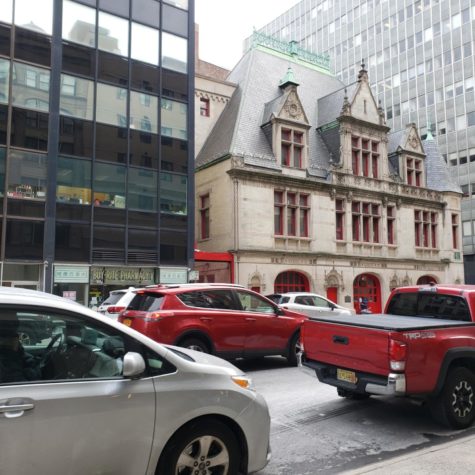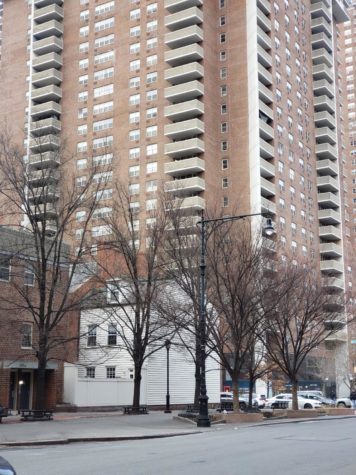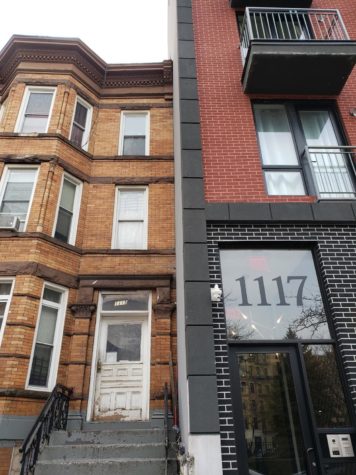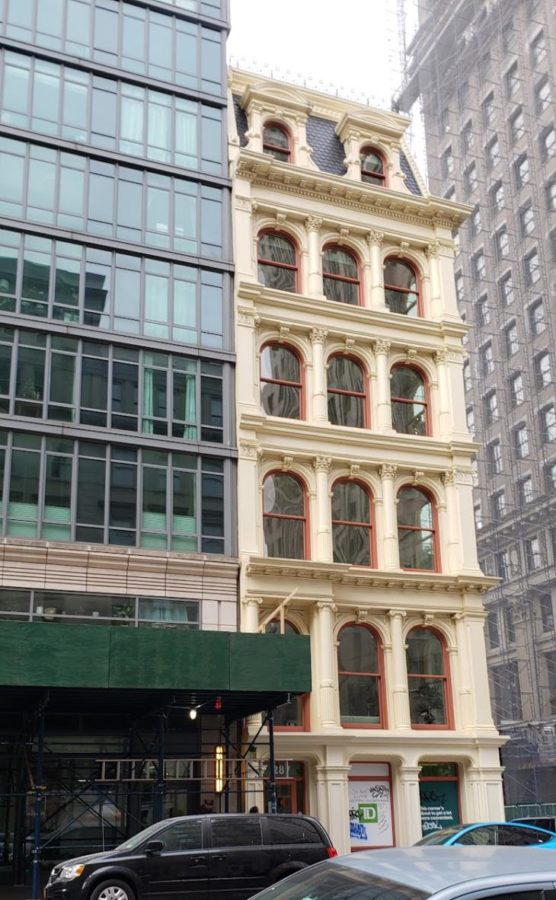The Ever Evolving Architecture of New York City
Architecture in New York City has been a cornerstone of the allure of the Big Apple. However, a shift towards minimalism in recent years is changing the face of the city.
This historical landmark, 287 Broadway, came close to disaster when it almost collapsed in 2008 due to construction next door. One of the last standing Civil War era iron cast buildings, 287 Broadway has seen its fair share of renovations to keep its antique facade, despite being surrounded by conflicting glossy buildings.
New York, being the city that never sleeps, also happens to be the city that never stops changing. Almost everywhere you go, there is scaffolding and cleared plots waiting for their concrete foundation to be laid. For such a dense city, where does this space come from? What is being removed to allow room for newer builds?
Architecture is a distinctive part of the history of New York City, and the many different styles that have influenced the city over the centuries are noticeable. Classic renown buildings like the Chrysler Building on Lexington Avenue and Rockefeller Plaza were built during the prominence of the Art Deco style, one of the thirteen architectural styles found in New York City, that incorporates geometric styling with linear design. When walking through the city, there are so many unique and detailed structures — isn’t that why tourists always look up when visiting?
As a melting pot of cultures, New York City has undergone many different influences in its architecture. Apart from the different styles within the overall architectural structure of New York City, immigration has also brought many different cultures to the city and has left a history in more personal ways than structures often do. Moving away from the symbols of wealth within the city, places like the tenements of the Lower East Side experienced multitudes of cultures. Not only do our buildings represent eras in architecture, they are also a physical history of the people who have added to the vast and perhaps indescribable cultural identity of New York City.
Looking at newer buildings, you may notice that there is a distinctly different and less-detailed style being adhered to. Minimalist architecture first rose to prominence in the 1960s and 70s, based on the principle that structures stripped down to their essentials create harmony. Minimalism is culturally and architecturally depreciating our city. The lack of detail and meaning doesn’t add value to New York City when compared to our multifaceted past. As Yiwen Xu ’25 noted, “Minimalist architecture takes away the personality and uniqueness of the architecture in New York City.”

Putting aside the blandness imbued by minimalism, a larger reason why newer renovations are reprehensible is because they are replacing strong cultural identifiers that are unique to New York City. Space is made for new structures by taking down older buildings. The City Investing Building, built from 1903-1908 during the Romanesque revival, and the Singer Building, completed in 1908 in the Beaux-Arts style, were neighbors for decades. However, they were taken down in 1968 and replaced with One Liberty Plaza, an architecturally minimalist skyscraper built in the International style. Although One Liberty Plaza offers the most office space in New York, the question we have to ask ourselves is: are these new buildings adding cultural value?
New York City has the Landmark Preservation Commission, a body of eleven commissioners and around 80 supporting staff of various scientific and administrative personnel whose job is to determine which buildings are beneficial – that is: hold cultural, historical, and architectural value for New York to be preserved. Buildings like the Empire State Building will never be taken down because of how iconic they are and how much wealth they generate for the city — almost $100 million in operating income in 2019 alone.
However, places like the tenements have not been able to withstand the progression of architecture despite how much they have contributed culturally to New York City. These are the places that are more likely to be replaced with minimalist architecture despite the fact that they were and still are epicenters of culture.
Not all of the buildings from the past are of such importance, as some structures, like the tenement houses and the landline buildings, lose their intended purpose over time. The tenement buildings of the 19th century could not be considered proper living spaces today, nor could the old landline buildings be used due to the rise in portable cellphone usage. However, these historic reminders of the past can serve as the “souls” of communities or a hint of what makes the place interesting.
“There’s been so many new buildings and tons of changes in the stores around my house. It’s depressing to see every time I go home. The places of my childhood just became a corporate cash grab,” noted Vanessa Encarnacion ’25. This issue of replacement doesn’t just affect historians and architects.

The city is renowned for its unique architecture that has over time incorporated centuries of style, multitudes of different cultures and peculiarities.
In addition to this, increased replacement of buildings with newer, advanced living spaces are not affordable to everyone. In a process known as gentrification: a gradual progression through which middle to upper class people move into historically poor neighborhoods and renovate, changing the landscape of the area and leading to social and economic prosperity. This, however, is not to the benefit of the original tenants as they often get evicted when they cannot afford the soaring rent prices. It is unequivocally true that newer buildings cost more to rent than older apartments.
There are two different ways to classify gentrification: the people who facilitate gentrification and the type of structural change seen in a gentrified area.
Typically, gentrification is viewed through the lens that middle-class people come and change the landscape of a neighborhood. However, there are other types of people who can gentrify. Other types of gentrifiers can consist of the government, who section off areas of a city for development; companies, who will buy out areas of a city for their own purposes; and super-gentrifiers, a form of gentrification classified by the urban geographer and urbanist, Loretta Lees, in which the ostentatiously rich change an already gentrified thriving neighborhood.
There are different ways that places can be gentrified. ‘Expansive gentrification’ is one way that emphasizes unanimous gentrification in many parts of a city to create overall stronger, more prosperous neighborhoods. Then, there is ‘concentrated gentrification,’ where, as the name suggests, gentrification begins in one small area and spreads out from there.
Moreover, most people do not consider these next two concepts as part of gentrification, however they are classified technically under area changes as gentrification. There is ‘limited gentrification’ often found in newer cities built up after World War II, which are largely suburban in structure, have larger white populations and lack a prevalence of a low-income community. Essentially, the suburban middle-class renovates their original living space to become more urban. These communities of mainly white populations exist because of policies that excluded people of color. On the other hand, ‘nascent gentrification’ occurs in newer cities that are also suburban in structure, lack a prevalent low-income community, but have a large black population, created by policies that limited where they could live. Unlike expansive and concentrated gentrification, the changes to the area are made by the preexisting community. When economic growth, awareness of improving your neighborhood, and investment in locally owned businesses are at the forefront of consciousness, that’s when real change happens. In all, while the architecture and economy of an area will change, the preexisting community and history remain in both nascent and limited gentrification. These types of gentrification make a neighborhood more expensive however lift the preexisting community with them instead of making the neighborhood unaffordable.

Gentrification within New York City specifically has been an enduring process and has gradually, but drastically, changed the city’s make-up as well as the manner in which it is perceived. A prime example of this is the Lower East Side (LES). Having been defined for centuries by immigrant working-class households, the LES began to gentrify rapidly in the mid-2000s. Since then, a number of buildings have been taken down and replaced with modern structures.
There is quite an important question looming: how does this connect to architecture and minimalism? Well, as mentioned before, newer buildings are more expensive to rent than older buildings are. This is understandable seeing as they more often have up-to-date utilities and require less work, which developers would capitalize on when advertising. Most of the recent buildings seen rising brick by brick in New York City are minimalist, modern in style, and stand out when set down in the backdrop of older brownstones and tenements. Minimalism in lower-income neighborhoods has become an indicator of gentrification.
We have all sorts of stories to tell, aside from the glamorous and shiny; these older buildings are a testament to how residents and structures alike have survived and had influence.
Minimalism is culturally and architecturally depreciating our city. The lack of detail and meaning doesn’t add value to New York City when compared to our multifaceted past.
Dara King is a Copy Chief for ‘The Science Survey.’ She loves the creative and intellectual opportunity that journalism can provide and the connection...











